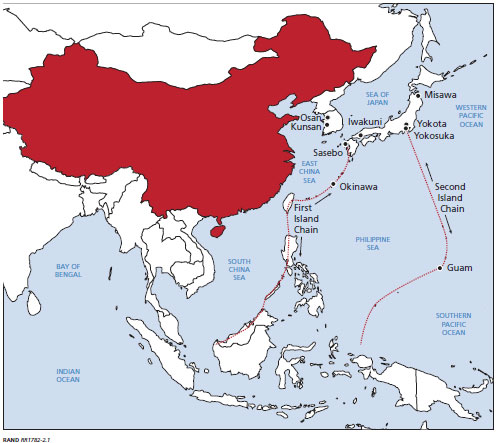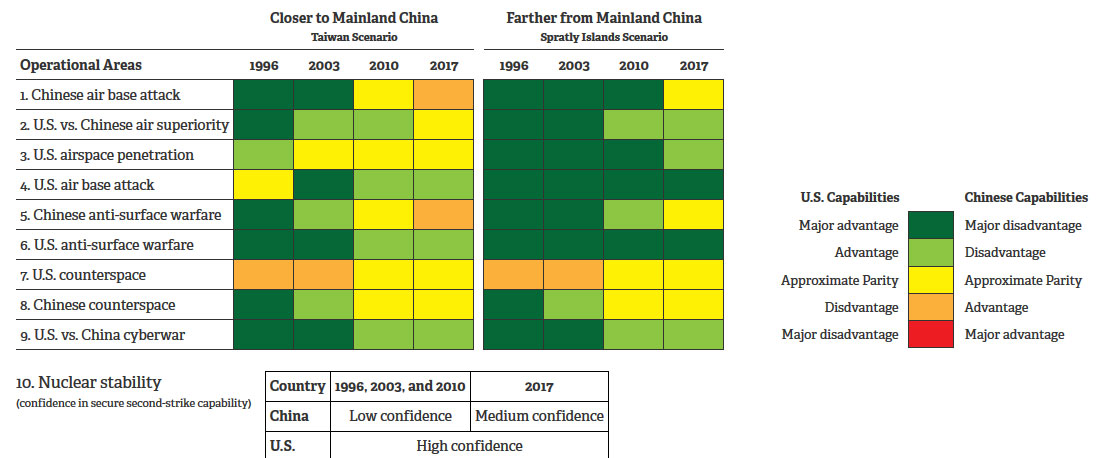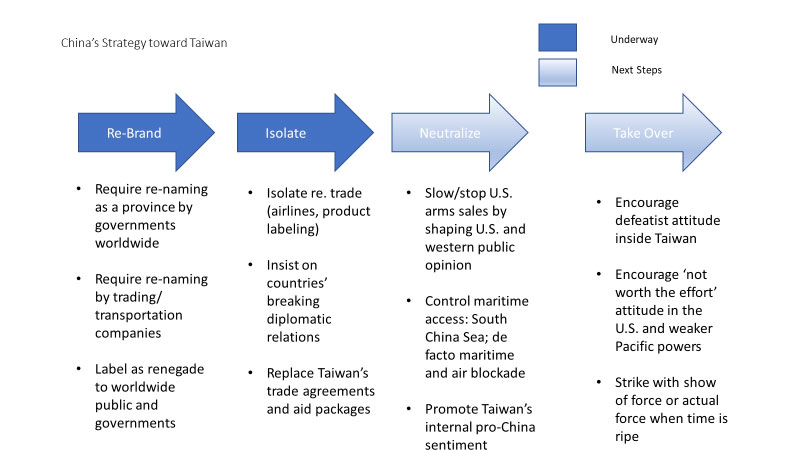China’s Strategy for the South China Sea and Taiwan
By Evan Dudik
In Part 1 I introduced a series of eight posts exploring how China has adopted a “grand strategy” to place itself more firmly on the world stage politically, militarily and economically. Here I delve into an important element of that strategy, China’s efforts to assert control of the sea immediately to its eastern shore, as well as Taiwan, its so-called breakaway province.
A good place to start is the disconnect between Xi’s proclaimed desire for “peaceful external environment and cooperative relations with major powers” and its actions—and rhetoric—regarding Taiwan and the South China Sea. ” If one defines ‘peaceful’ narrowly as the mere absence of a shooting war, this phrase could possibly stand—for the present. And you’d have to define ‘shooting war’ to exclude today’ maritime brinksmanship that risks ship to ship collision and exchange of gunfire. Likewise, if you define ‘cooperative relations with major powers’ narrowly as being willing to take US dollars and Euros in exchange for manufactured goods via a manipulated currency, this phrase could possibly stand—for the present.
We must parse Xi’s “authoritative” statement with surgical care to wonder how peaceful it is to build artificial islands to create military bases in the South China Sea. How internationally “cooperative” is it to build those islands in international and economic zone areas (of the Philippines at least) in defiance of UN Convention on the Law of the Sea (UNCLOS)? In July 2016, the Permanent Court of Arbitration handed down a decision on the case, ruling in favor of the Philippines on July 12, 2016. [3]. How internationally cooperative is it to defy the Declaration of the South China Sea authored by the Association of South East Asian National (ASEAN) and to which China is a signatory? To date, China has not “cooperatively” or otherwise evacuated the artificial islands it has constructed. Instead it has fortified them, turning them into hardened air bases. As to “peaceful external relations” The Economist reports “growing evidence of radar installations and bomber-sized bunkers made of reinforced concrete. Last month came the revelation that China had installed anti-ship and surface-to-air missiles on three islands in the Spratly archipelago west of the Philippines—far, far from its own shores.” [4].
It would take a subtle observer indeed to maintain that “China now interacts with the international order like other major states” as Professor Thomas would have it.
How does the de facto militarization and occupation of the Spratly Islands figure into China’s grand strategy? We have a clue in the fact that 70,000 ships transit the area yearly, carrying more than half of the world’s international trade. [5] China would dearly love to control the throttle to this trade, now protected by the United States Navy. Control of this commercial transit route would make every global trading partner dependent on the good graces of China. If true to its history, China would probably demand tribute payments. The U.S. provides sea lane protection free of charge.
Nor does China’s “commitment to peaceful development and external cooperation” extend to the second plank in China’s Taiwan strategy. China doesn’t recognize the Republic of Taiwan as an independent nation, maintaining that it is a ‘renegade’ province. The pejorative ‘renegade’ hides the fact that the majority of Taiwanese have repeatedly and recently expressed their desire to remain independent of China. (Same for the folks in Hong Kong, but their train has left the station). In fact, according to the New York Times peace-loving “Beijing has said that any official name change to “Taiwan” would be met with a military attack.” [6]. China has recently forced international airlines serving Taiwan to change their websites to eliminate any reference to Taiwan as a country. [7]. China recognizes only “Taiwan Province, People’s Republic of China.”
Security analyst Samantha Hoffman at the Australian strategic Policy Institute told DefenseOne that such impositions by China on the use of terminology is “changing over time the way people perceive Taiwan and Taiwan’s status which actually the CCP (Chinese Communist Party)’s been fairly effective with over the years” [8]
Returning Taiwan to the China fold is clearly a goal of China’s grand strategy. Not only has it been a fixture of Chinese rhetoric since Mao Tse-Tung took over the mainland but Taiwan’s geographical location renders control of Taiwan imperative, from Beijing’s point of view. The Taiwan Strait connects the East China Sea and the South China Sea; in non-US hands US ally the Philippines are neutralized—as the US learned at heavy cost on Dec. 7/8, 1941. Most strategists, including those in the US Department of Defense, believe that China sees Taiwan as the biggest and most important element in a future base for projecting power in the Pacific, as part of a “First Island Chain,” ranging from Malaysia to Japan. The “First Island” chain with naval and air bases would serve as a line of defense against an aggressive USA and not so coincidentally as a platform to project power into the western Pacific. We’ve seen this movie before, as the Japanese had a similar concept of defending the Empire via a network of Pacific Islands at the outset of World War II.
Here is the famed consulting firm RAND’s map of the First Island Chain [9]. Note there’s a Second Island Chain China seeks to control. It encompasses the US possession of Guam, an important US base and home to 160,000 U.S. citizens—not to mention embracing the Philippines and Indonesia:

[Courtesy, RAND Corporation, 2017].
Nevertheless, the trend is troubling. RAND has succinctly summarized China’s success toward neutralizing US power in the region.
An Interactive Look at the U.S.-China Military Scorecard

[RAND Corp, “An Interactive Look at the U.S.-China Military Scorecard”, 2017]
So taking into account China’s policy objectives and Taiwan’s military capabilities and alliance with the US, here are the elements of the Taiwan plank in China’s grand strategy. This plank is laminated from 4 strata, each reinforcing the others:
- Isolate Taiwan psychologically. This is exemplified by Beijing’s recent crackdown on how international airlines advertise their flights to Taipei: never allow mention of Taiwan or the Republic of Taiwan. This starts the campaign of estrangement of Taiwan from public opinion in the US. Many have remarked on the short memory and even shorter attention span the US public has; the process of forgetting US support of Taiwan after the Communist mainland takeover proceeds apace. And we shouldn’t forget China’s attempts to change attitudes inside Taiwan, through propaganda, nice words about a “one country two systems” policy a la Hong Kong and Macao. “It won’t be so bad” to join our totalitarian adventure. The promise is that the prodigal province would be welcomed back to the Communist fold with open arms.
- Isolate Taiwan diplomatically. As China’s wealth and diplomatic heft increase, more and more countries are cutting their official diplomatic recognition of the Republic of China (Taiwan). As of September 2019, only 15 countries recognize Taiwan [13]. Taiwan has tried to counter this by financing relief projects in the Third World, but now China has the money to compete—and of course dangles the carrot of its huge home market and future aid, to all countries, tying aid to ending recognition of Taiwan.
- Isolate Taiwan militarily: Increase military capability in the South China Sea in general and around Taiwan in particular. Objective: to push the US to consider whether defending Taiwan, perhaps unsuccessfully, is worth the cost in blood and treasure, especially as the US has obligations in the Middle East and to deter Russia in Europe. This includes suborning traditional US ally, the Philippines with aid, promise of access to China’s markets. Are the Philippines taking the bait? “Do we still have a Cold War today? Is [our alliance with the United States] still relevant to our security? Maybe not,” declared Philippine defense secretary Delfin Lorenzana in a slightly belated Dec. 28, 2018 Christmas present to Beijing; a surprise because Lorenzana had been seen as a staunch advocate of the 1951 mutual defense treaty with the US [14].
- Play it cool for a year, maybe five years, maybe two decades, so that Taiwan recedes from America’s consciousness. By this time the costs of helping Taiwan defend itself will have risen to astronomical levels. It will be impossible to convince Americans to sacrifice their sons and daughters to defend an island the Chinese have packaged to the rest of the world as a wayward lamb being brought back into the fold.
Through these steps, China’s grand strategy aims to accomplish its goal of reunification without firing a rocket.

Next week, I’ll look at how the Chinese will seek to deal with the U.S. presence at sea in and space by taking advantage of the Americans’ perceived weaknesses.
